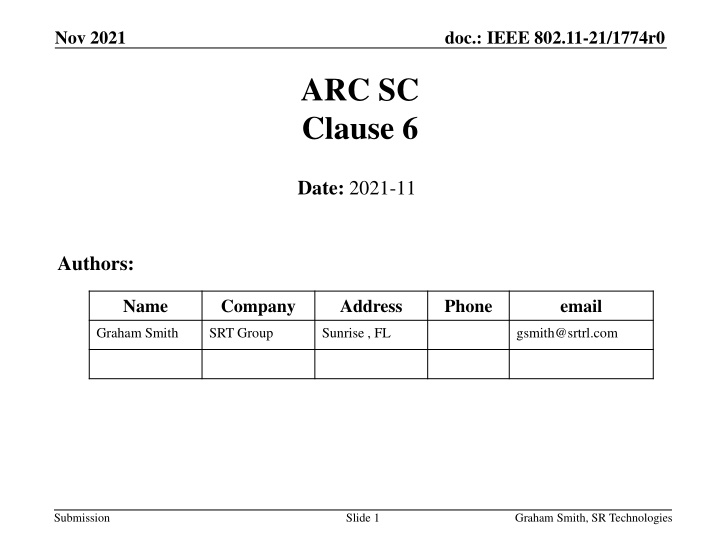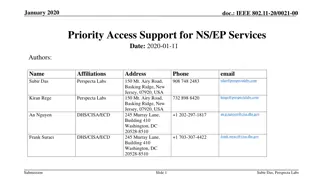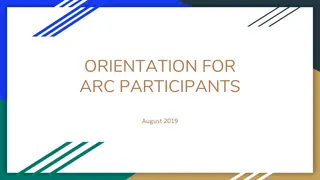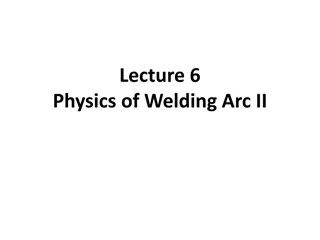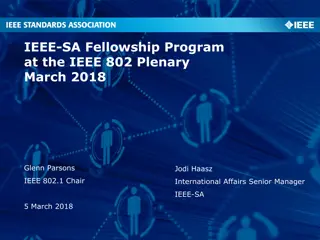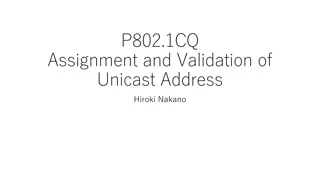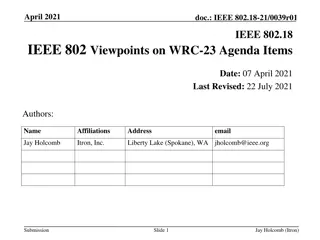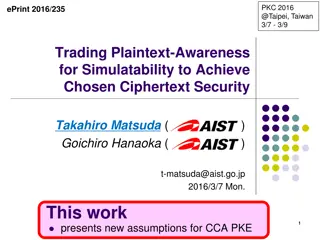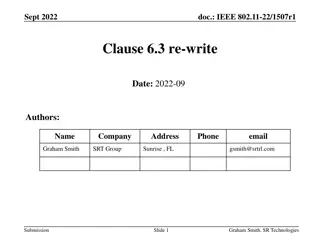IEEE 802.11-21/1774r0 ARC Clause 6: Overview of Management Primitives
This content delves into Clause 6 of IEEE 802.11-21/1774r0, focusing on the overview of management primitives such as SME, MLME, PLME, and SAP. It discusses the communication between SME and MAC, generic management primitives dealing with MIBs, and MLME SAP Interface services in an abstract manner. Explore the evolution of software since ITU-T X.210 was published in 1993 and the relevance of these concepts in current contexts.
Download Presentation

Please find below an Image/Link to download the presentation.
The content on the website is provided AS IS for your information and personal use only. It may not be sold, licensed, or shared on other websites without obtaining consent from the author.If you encounter any issues during the download, it is possible that the publisher has removed the file from their server.
You are allowed to download the files provided on this website for personal or commercial use, subject to the condition that they are used lawfully. All files are the property of their respective owners.
The content on the website is provided AS IS for your information and personal use only. It may not be sold, licensed, or shared on other websites without obtaining consent from the author.
E N D
Presentation Transcript
Nov 2021 doc.: IEEE 802.11-21/1774r0 ARC SC Clause 6 Date: 2021-11 Authors: Name Company Address Phone email Graham Smith SRT Group Sunrise , FL gsmith@srtrl.com Submission Slide 1 Graham Smith, SR Technologies
Nov 2021 doc.: IEEE 802.11-21/1774r0 Intro I was writing text which has a series of Request/Response Action frames. I realized that I should add these to Clause 6. It s easy , I am told, just boilerplate. First of all I read the introductions and attempted to write my new text. It did not take long before I thought Is this right? , Why am I repeating myself 4 times? , When is a response not a response? and then Know what, how is this useful when I have the frame formats in Clause 9, and how to use them in Clause 11. NOTE: Clause 6 is 434 pages (D0.3), Compare to Clause 11, 398 pages Submission Slide 2 Graham Smith, SR Technologies
Nov 2021 doc.: IEEE 802.11-21/1774r0 ITU-T X.210 Clause 6 comes from ITU-T X.210 Published 11/1993 (almost 30 years ago) I am not a software expert, but I am willing to bet that software has changed a bit since then: Microsoft Windows NT 3.1 released July 1993 MS-DOS 6 introduced March 1993 Intel Pentium P5 66 MHz, March 1993 Submission Slide 3 Graham Smith, SR Technologies
Nov 2021 doc.: IEEE 802.11-21/1774r0 Clause 6 6.1. Overview First some acronyms (because I never remember : SME Station management entity MLME MAC sublayer management entity PLME PHY layer management entity SAP Service Access Point The SME talks to the MAC via the SME-MLME SAP Submission Slide 4 Graham Smith, SR Technologies
Nov 2021 doc.: IEEE 802.11-21/1774r0 Clause 6.2 6.2 Generic management primitives This deals with MIBs and is XX-GET to request the value of a MIBattribute XX-SET to request a MIB attribute is set to a given value. Sequence is XX-GET.request XX-GET.confirm (success?) XX-SET.request XX-SET.confirm However, all the primitives are in Clause 6.3, (So why this Clause 6.2 is present I am still struggling with) MLME SAP interface Submission Slide 5 Graham Smith, SR Technologies
Nov 2021 doc.: IEEE 802.11-21/1774r0 Clause 6.3 MLME SAP Interface These services are described in an abstract way and do not imply any particular implementation . Hmm that s a good start MLME SAP primitives are of the general form ACTION.request primitive, Initiates request for a procedure ACTION.confirm primitive (for an exchange initiated by the SAP client) Reports result of request (success?) ACTION.indication primitive Result of receipt of request for procedure ACTION.response primitive (for an exchange initiated by the MLME) Initiate transmission of the requested procedure (by the other peer) Submission Slide 6 Graham Smith, SR Technologies
Nov 2021 doc.: IEEE 802.11-21/1774r0 Example MLME-ASSOCIATE MLME-ASSOCIATE.request The primitive parameters number 27. All described in detail, but (hopefully) the same details as in table in the Association Request frame format. Looking at the frame Association Request frame 9.3.3.5 I see 45 fields in the frame body This is explained as follows: Additional parameters needed to perform the association procedure are not included in the primitive parameter list since the MLME already has that data (maintained as internal state) OK, but is this list checked and confirmed? Who makes that decision? For example, Supported Channels is present, but Capabilities and Extended Capabilities are not. What does it mean, that the MLME already knows? The services do not imply any particular implementation so is this independent of implementation as to where certain parameters reside? Submission Slide 7 Graham Smith, SR Technologies
Nov 2021 doc.: IEEE 802.11-21/1774r0 MLME-ASSOCIATE After .request we have : MLME-ASSOCIATE.confirm Repeat the same 27 parameters as a list and then in detail in a Table, with STATUS. Yep, got the message, notify the SME MLME-ASSOCIATE.indication Repeat the same 27 parameters as a list and then in detail in a Table. SME is notified of the receipt message to send Association request (So the MAC got it, tells SME it got it, then tells SME I ll send it on and hopefully MAC sends it?) MLME-ASSOCIATE.response Initiates an Association Response to the specific peer MAC entity that requested association The Response frame is initiated by the other guy. 18 pages in total. What did we learn? What s new? Send it got the message sent it. Does it all agree with 9.3.3.5 and 9.3.3.6? Would anyone bother to check what does the MAC already know? Submission Slide 8 Graham Smith, SR Technologies
Nov 2021 doc.: IEEE 802.11-21/1774r0 Questions? Why does Measurement Report only have .request and .confirm? Does it not expect an answer? Where does Clause 6 answer anything not covered by Clauses 9 and 11? True there are many references to the primitives in Clause 11, but could easily be re-written (to my mind) Note: Informed that Where clause 6 is useful, is when the mapping between the protocol and the service provided isn t obvious example SCAN Submission Slide 9 Graham Smith, SR Technologies
Nov 2021 doc.: IEEE 802.11-21/1774r0 MLME-SCAN This primitive requests a survey of potential BSSs that the STA can later select to try to connect .request - requests a survey .confirm - This primitive returns the descriptions of the set of BSSs detected by the scan process. Multiple MLME-SCAN.confirm primitives can be issued when the value of the ReportingOption parameter in the MLME-SCAN.request primitive is CHANNEL_SPECIFIC or IMMEDIATE. When the value of the ReportingOption parameter is AT_END, or the ReportingOption parameter is not present, a single MLMESCAN.confirm primitive is issued. Seems to me to be simple status and option settings. Easily covered in Clause 11. NOTE: No .indication WHY? Then, SCAN STOP.response - The SME is notified of the results of the scan procedure and stops? QUESTION? - IS THIS NOT IN 11.1.4.3.2 Active Scanning procedure for a non-DMG STA? AND 11.1.4.3.3. Active Scanning procedure for a DMG STA? Are these primitives common for both? Submission Slide 10 Graham Smith, SR Technologies
Nov 2021 doc.: IEEE 802.11-21/1774r0 Reference to the primitives in Clause 11 Example: If the ReportingOption parameter of the MLME-SCAN.request primitive is IMMEDIATE, and the scanning FILS STA detects a BSS whose MLME-SCAN.confirm primitive has not been issued during the ongoing scan, then an MLME-SCAN.confirm primitive with the ResultCode equal to INTERMEDIATE_SCAN_RESULT and one or more of BSSDescriptionSet, BSSDescriptionFromFDSet, or BSSDescriptionFromMeasurementPilotSet containing information of the detected BSS is immediately issued. But to me, that could have been written with reference to the fields Reporting Option, and Result Code. There are many places where a primitive is referred to, and maybe MLME START is a good example but I ask the question if the SW writer actually needs it? Can it be written out? Submission Slide 11 Graham Smith, SR Technologies
Nov 2021 doc.: IEEE 802.11-21/1774r0 Why am I concerned? I found myself writing 9 pages of primitives, when I was not really sure I was doing it right, tried to use boiler-plate based on Clause 9 frame formats and Clause 11 description. Could it be that only a few of the basic primitives are really required? Could it be that the primitives could be deleted, and covered clearer in Clause 11? Could it be that we need only a few fundamental primitives ? And not all the boiler-plate Request/Responses and Action frames? Do SW writers/developers use/rely on Clause 6? Clause 6 is normative so how sure are we it covers everything correctly? Again, I do admit I am not a SW developer so I do defer to those who are. BUT to have 434 pages of normative text in Clause 6, that hopefully agrees with Clause 9 and Clause 11, to me, is superfluous is it? Submission Slide 12 Graham Smith, SR Technologies
Nov 2021 doc.: IEEE 802.11-21/1774r0 STRAW POLL Do you agree that Clause 6 should be investigated? Note: Clause 6 could be investigated as to one or more of the following: Usefulness? How useful is it really? Better clarification on how it is used (i.e., clear rules)? Is the boiler plate clear? When to use .confirm, .indication? Reduction to small list of essential (or fundamental) primitives Accuracy does it agree with Clause 9 and 11, is it correct on features that the MAC knows? Possible obsolescence? What s involved in deleting Clause, and would it be missed? Submission Slide 13 Graham Smith, SR Technologies
